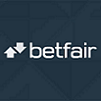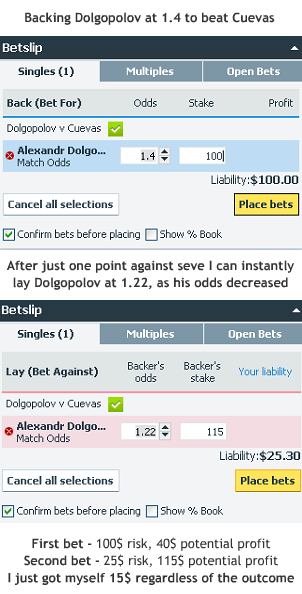Betting exchange & trading guide. How does it work, how do you do it?
The first thing one needs to know is what exactly a betting exchange is. A betting exchange is a platform for players to bet one against eachother, unlike traditional bookmakers. You can bet on odds created by other punters, or you can create your own odds for others to bet on. It`s deadly similar to a stock exchange, with the difference that you are trading odds instead of shares. This will be more of a beginners guide intro trading and betting exchange, it couldn`t be anything else since intermediate and expert levels can only be achieved with experience. My betting exchange of choice is Betfair, so we`ll work with their platform in this guide.
On a betting exchange you have two basic options: Back and Lay.
Back is the usual bet you are placing at any traditional bookmaker. You are backing a result to happen.
Lay means creating your own odds for other punters to back. When you are laying a certain team, you are basically betting against that team – you expect punters to bet on that team at your own odds, thus practically becoming a bookmaker yourself.
I always believed that the best representation comes through example. For better understanding, let`s try a graphical approach. (click on the image to expand in a new tab).
You can see the back and lay options in the center of the image (highlighted in red with my insane Paint skills). Backing is the easy part – just click on the blue 2.58 button to bet on Cardiff at odds 2.58, just like with a regular bookmaker.
Lay is a little more tricky. For example, let`s say you don`t think Cardiff will win – so you are creating odds on Cardiff for others to bet on. You choose to lay Cardiff at 2.60 (you are offering odds of 2.60 for a Cardiff win) and you want to win 50$. On the right of the image, you can see that you have to introduce the amount you WANT TO WIN as a stake (50$ – backer`s stake), and have a liability of 80$ if you want to win 50$. So what you are doing is you are providing odds of 2.60 for other people to bet on Cardiff, but setting a betting limit of 80$ – your maximum accepted loss. Basically you`re betting 80$ on X2 (against Cardiff).
On the left, highlighted in red, you can see exactly where you stand with your potential profits and losses on the event. Wrap your head around it for a couple of minutes and you should be able to understand. Take a break, swear on me because of my poor explaining skills, and read again with the illustration in mind. You`ll get it on a basic level for sure.
Let`s try another way of explaining. When you are betting 100$ on Cardiff at odds 2.60 at a traditional bookmaker, that means you backed Cardiff with 100$ and the bookmaker layed Cardiff at 2.60 with 160 dollars (your potential profit).
Other relevant details in the image above:
- Under every odds, you can see an amount of money. That is the total amount of unmatched money available at that current price. For example, if you want to bet 3000$ on Cardiff, you have to bet 2273$ at odds 2.58 and the rest at odds 2.56 – as there`s not enough money available at 2.58.
- Matched: 166,458. This means a total of 166,458$ have been matched on the 1×2 market for this game. A matched bet means a bet that has been successfully sold/bought. An unmatched bet is a bet that hasn`t currently been matched: for example, you want to bet (back) on Cardiff, but only at odds. 2.64. You can place this bet, but you have to wait for someone to offer these odds – until then, it`s unmatched.
- The odds in colors are the highest current available prices. The odds in white are next to best current available prices
Now that we can see how a betting exchange works, what is trading? Trading is the sum of actions you are taking on the betting exchange – you are trading bets and odds, just like when in a stock exchange you are trading shares. You`re betting on Cardiff pre-game and then laying them in-play to gain a sure-win or limit your losses – that`s trading (also known as arbitrage betting or hedging). Usually you`re not necessarily looking for a particular competitor to win, instead you are looking to anticipate the movement of the odds.
What`s so much better at trading on betting exchanges then traditional betting? Among others:
- better odds
- much better control
- real time, massive odds movement allows you to trade efficiently
- in-play offer and odds movement way better than any traditional bookmaker
- being able to act like a bookie yourself
- influence the market yourself, pushing to get the odds you want
The downside of trading is it is a professional activity, and as any such activity, it requires time. You have to be able to study the odds, keep an eye on them, be focused and reactive in-play. You have to spend some good hours in front of the computer per day if you want to be successful. Also, all betting exchanges demand a commission of about 5% from the profit of every winning bet, but that is not a real downside considering the top-class odds. Other downsides are no different than the usual: don`t get greedy, close the bet when you have the chance (when you can assure yourself you`ll win regardless of the outcome), don`t lose discipline.
My input is, if you understood this guide and are interested in trading, just take 10-20 dollars, go to Betfair and get some ‘real-world’ experience. There`s just no other way to get more, real insight. The guide wasn`t helpful enough? Hit us at one of our contact options and we`ll settle any questions you might have.
 Betdistrict.com
Betdistrict.com





